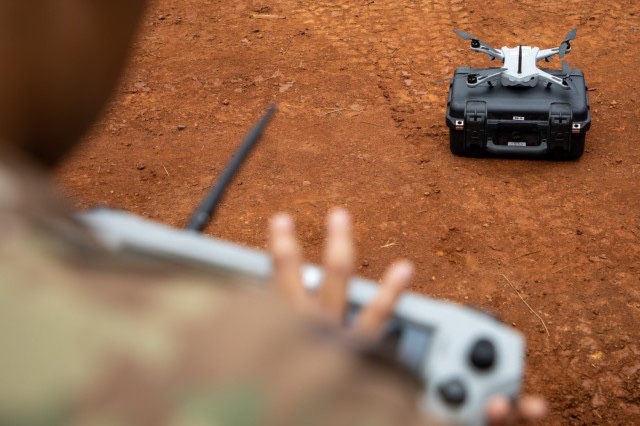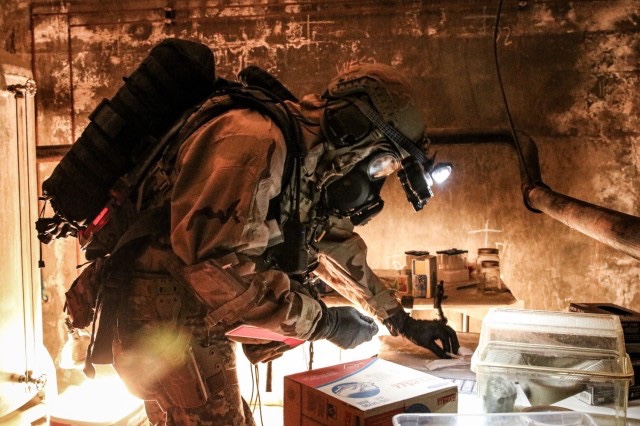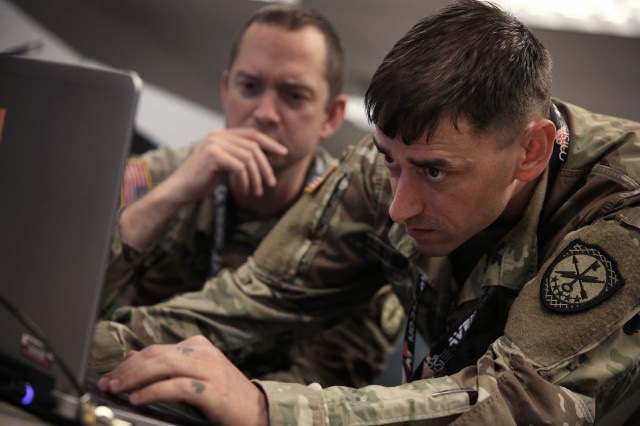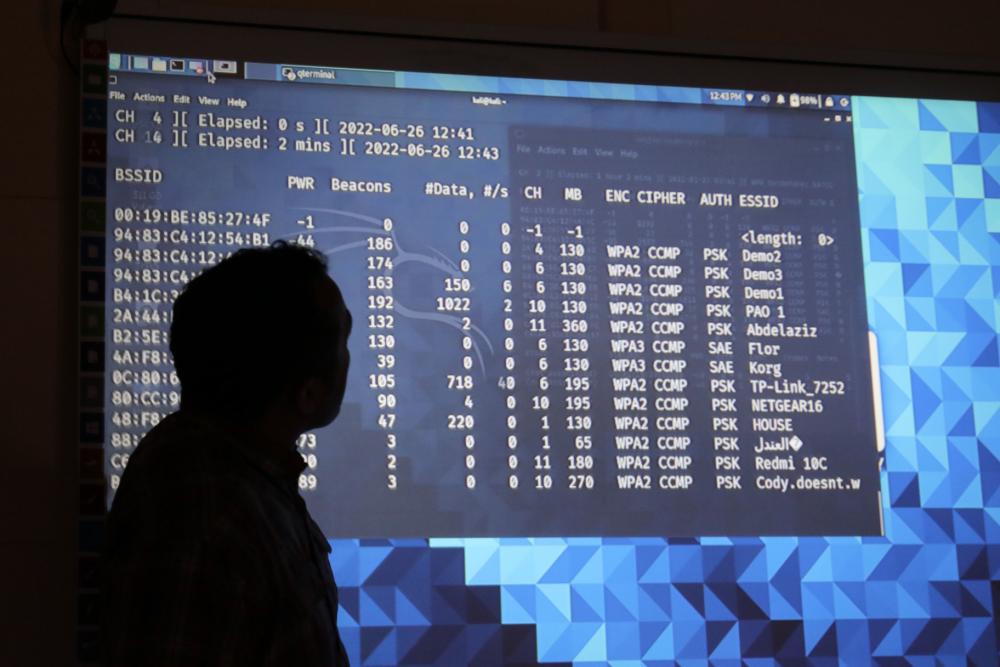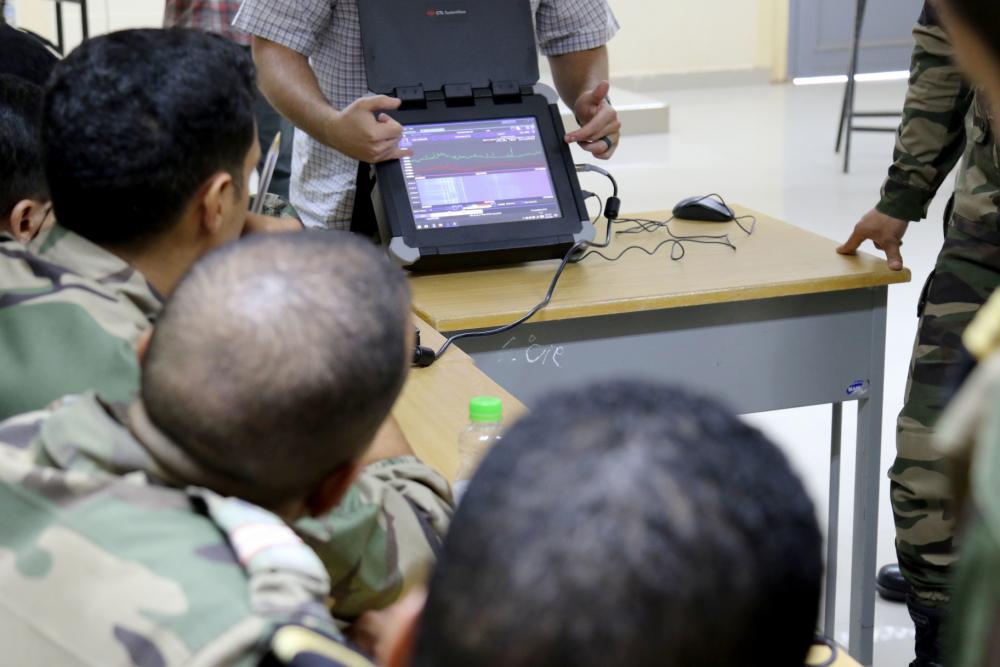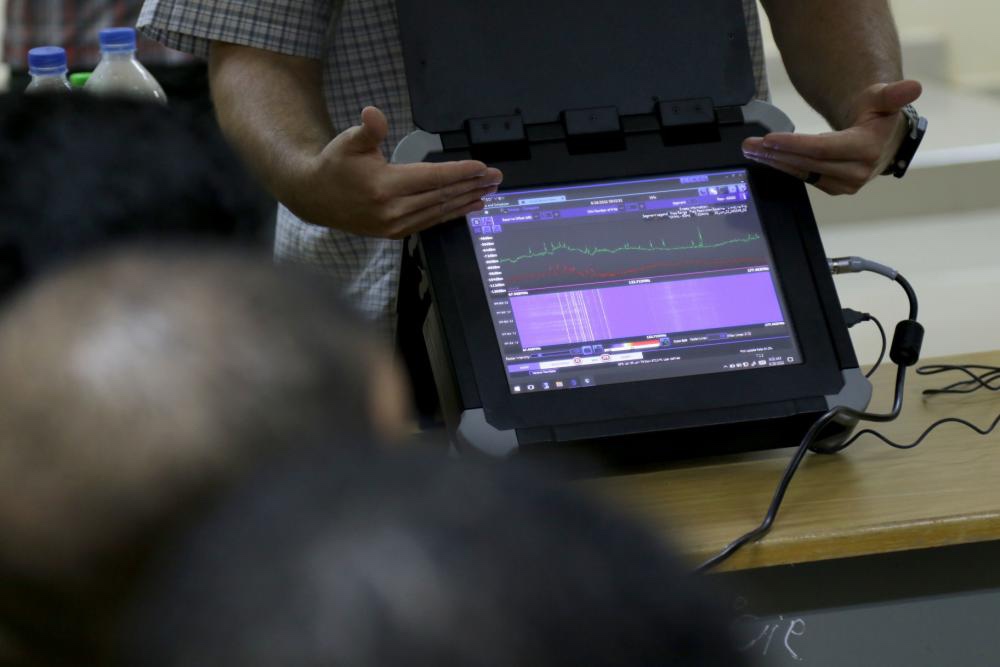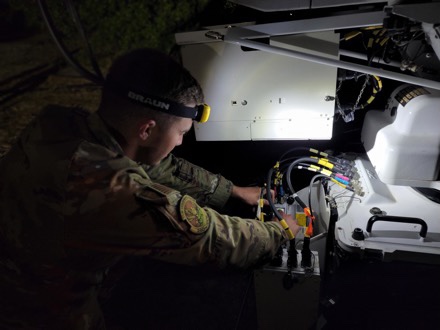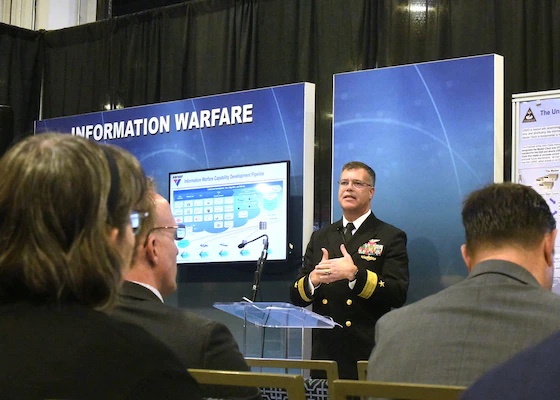The second annual Information Warfare (IW) Community summer cruise got underway in Suffolk, Va., in early June with the first of three waves of U.S. Naval Academy (USNA) First Class Midshipmen touring various IW commands.

Vice Adm. Kelly Aeschbach, commander of Naval Information Forces, welcomes U.S. Naval Academy midshipmen on their first day of the 2022 Information Warfare (IW) Community Cruise. Midshipmen will tour various commands throughout the week and see first-hand how the IW enterprise broadly impacts the Navy. Naval Information Forces generates, directly and through leadership of the IW Enterprise, agile and technically superior manned, trained, equipped and certified combat-ready Navy Information Warfare forces to ensure our Navy will decisively deter, compete and win in today’s strategic competition. (U.S. Navy Photo by Robert Fluegel/Released)
Designed to fully explore how fleet-wide IW capabilities underpin all other warfighting operations, the Midshipmen took a deep dive in each of the IW disciplines: Cryptologic Warfare (CW), Cyber Warfare Engineer (CWE), Information Professional (IP), Intelligence (Intel), and Meteorology and Oceanography (METOC). This firsthand look at real-world environments and speaking directly to IW Community officers prepared the midshipmen for service selection week. The goal is to have the IW Community make a strong, positive impression on the midshipmen to help them decide if a career in IW is right for them, and then select which strand of IW is the best fit.
Each wave of the IW Community Cruise started with Core Week, during which Midshipmen collectively received briefings and visited various IW commands in Hampton Roads. The first welcome brief was presented by Rear Adm. Michael Vernazza, then commander, Naval Information Warfare Development Center (NIWDC). Vice Adm. Kelly Aeschbach, Commander, Naval Information Forces (NAVIFOR), made the next two presentations. Vernazza and Aeschbach, both Intelligence officers, delivered a unified message to each group of midshipmen.
“In today’s environment, we are in constant competition with our adversaries, and in every fight, information warfare is and will continue to be constantly in demand,” said Aeschbach. “It will be you who will lead our Navy into the next generation of IW, leading the charge for the next wave of critical thinking and problem-solving for the Navy. I encourage you to learn, ask questions, and be curious as you see firsthand over the next few weeks what IW brings to the fight.”
The welcome brief was held at the joint Navy Cyber Defense Operations Command (NCDOC) / Naval Network Warfare Command (NNWC) building in Suffolk, Va. There the midshipmen toured the joint watch floor and discussed NCDOC’s mission priorities, which included the Navy Red Team that tests the Navy’s networks for vulnerabilities. NNWC – conducting vulnerability assessments of Navy networks to reduce risk to the DoDIN-N, or DoD Information Networks – Navy – was also a topic. Additionally, the midshipmen learned about the cloud watch floor charged with ensuring a secure migration of all NMCI accounts to a cloud-based platform that works in conjunction with Microsoft. Between the two commands, the touring midshipmen learned about the hand-in-hand working relationship with the Fleet in exercises, operations, and for network compromises.
MIDN Michael Schaefer capsulized the intent of the IW Summer Cruise. “I am cleared for either Intel or CW, so I desire to know about both and what they do on any given day,” Schaefer said. “I want to see how well I can keep up with that day-to-day life as that’s an important part of learning about a community.”
Throughout the three-week experience, each block of Midshipmen toured a combination of commands, ships and squadrons in the Hampton Roads area that included Fleet Weather Center Norfolk (FWC-N); U.S. Fleet Forces Maritime Operations Center (FFC MOC); Navy Expeditionary Intelligence Command (NEIC); Naval Special Warfare; Naval Computer & Telecommunications Area Master Station Atlantic (NCTAMS LANT); and various ships and squadrons.
Capt. Erin Acosta, commanding officer of FWC-N, outlined how meteorology and oceanography plays a major role in naval operations and explained the capability Naval Oceanography brings to the Fleet. “Equally as important is how we integrate with the larger IW enterprise,” said Acosta. “It is wonderful to see our Sailors, both enlisted and officers, and civilians interact and teach these future leaders how we do our job at the Weather Center.”
After the brief, the midshipmen toured the FWC watch floor to get a feel for a day in the life of a METOC officer. “The visit provides the midshipmen an excellent opportunity to ask questions and to assist them in making an informed career decision. Every Sailor is a recruiter and my team did an amazing job hosting the midshipmen,” said Acosta, a class of 2000 USNA graduate. “I’m blown away by the talent and diversity of these future officers. I am truly excited for them and for the Navy.”
After Core Week, the midshipmen splintered off into Strand Week. The length of this part of the IW Community Cruise lasted from one to two weeks, depending on the chosen designator. Some midshipmen remained in the Hampton Roads area while others headed to Fort Meade, Md. Commands toured in the Maryland area included Fleet Cyber Command / 10th Fleet and their MOC watch floor; Office of Naval Intelligence; Cryptologic Warfare Group SIX; Navy Cyber Warfare Development Group, and Defense Special Missile and Aerospace Center.
USNA’s Class of 2023 is the second to participate in the IW Cruise, and the experience was well received, according to Midshipman 1st Class Kristofer Gamalong Medina, who embarked on the IW Cruise with the intent of continuing in the CW community. “I’ll stay with my choice of designator (CW). As a prior enlisted Sailor, Cryptologic Technician Technical, I had only seen CW on a tactical level,” said Medina. “But learning how we affect the national scale was mind blowing to me. I was fascinated by the type of people leading those missions, the information we find, and how we can make an impact on the bigger picture of naval warfare.”
Of the IW Cruise overall Medina said, “The most beneficial part was seeing the different applications all the communities had. I did not know that there were so many divisions that focused on different things, and that they relied on each other to create the best picture for the warfighters.”
The IW Community Cruise is an annual event, divided into two or three blocks to allow for maximum participation. This year the last wave included three Recruit Officer Training Command (ROTC) students. Midshipman 1st Class Tai T. Nguyen, a University of Southern California ROTC student, stated in his biography, “I always wanted to work in the field of cyber security for its intellectually challenging mission, which is to stop foreign cyber threats to the United States. Therefore, becoming a cyber warfare engineer is my dream job.”
NAVIFOR’s mission is to generate, directly and through our leadership of the IW Enterprise, agile and technically superior manned, trained, equipped, and certified combat-ready IW forces to ensure our Navy will decisively DETER, COMPETE, and WIN.
For more information on NAVIFOR, visit the command Facebook page at www.facebook.com/NavalInformationForces or the public web page at www.navifor.usff.navy.mil.




